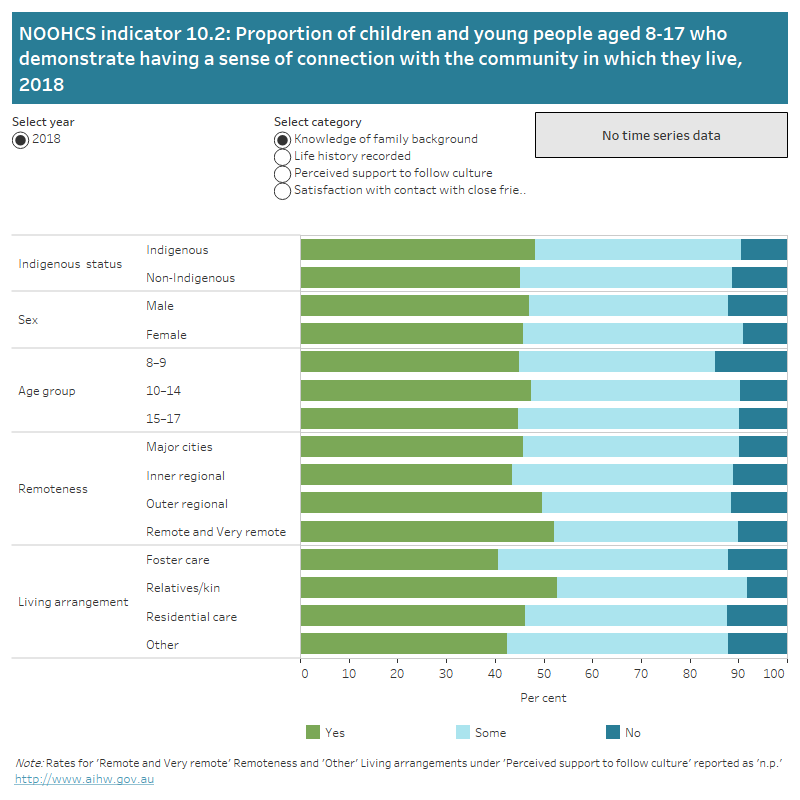10.2 Sense of community
Children may be in care due to abuse or neglect, or because their family is unable to care for them (for example, due to illness or incarceration). It is important that children in care have the opportunity to participate in decision-making about their lives.
This indicator uses results from a national survey of children in care; those whose care arrangements have been ordered through the Children’s Court, where parental responsibility for the child or young person has been transferred to the Minister/Chief Executive.
Children were asked about their sense of community connection through knowledge of family background, participation in religion, beliefs or customs, contact with friends, and whether their life history was being recorded (for example photos, memory box). For these data, sense of community connection is demonstrated when children report ‘at least some’ for the area in question.
Trend data: For all indicator displays, the yearly trend is limited to indicators with 3 or more years (including the current year) of comparable time series data. To see the trend click on “Yearly Trend” button on the display. Where 3 or more years of comparable data including the most recent year is not available, a “No time series data” message is shown on the display.
The horizontal stacked bar graph shows the proportion of children and young people aged 8–17 who demonstrate having a sense of connection with the community in which they live in 2018. Each bar presents the proportion who reported yes, some and no. Data are disaggregated by Indigenous status, sex, age group, remoteness and living arrangement. Data can be selected by the type of connection reported.

Source: AIHW Out-of-home care survey national dataset 2018
See the supplementary data tables for further information and footnotes about these data.
Indicator technical specifications
The information below provides technical specifications for the summary indicator data presented in the quick reference guide.
| Definition | Data source | |
|---|---|---|
| Numerator | Number of children aged 8-17 years in care who report they have at least some knowledge of their family background and culture | AIHW Out-of-home care survey national dataset |
| Denominator | Number of responding children aged 8-17 years in the reference period | AIHW Out-of-home care survey national dataset |
Explanatory notes
Data are sourced from a national survey of children in care. Further interpretive information for the indicators, and background information on the survey, is provided in the AIHW report The views of children and young people in out-of-home care: overview of indicator results from second national survey, 2018.
Children ‘in care’ are those who were residing in out-of-home care (including foster care, relative/kinship care, family group homes, residential care and independent living), whose care arrangements had been ordered by the relevant Children’s Court and where the parental responsibility for the child had been transferred to the Minister or Chief Executive, and who had been on a relevant court order for three months or more. Please note that the titles of the relevant ‘Children’s Courts’ may vary across states/territories.
Children aged 8-17 years were asked four questions in relation to this indicator: ‘How much do you know about your family background and your culture?’, ‘Do you keep things about your life, such as photos, a life story book, or a memory box?’, ‘How much can you follow your culture where you live? By ‘culture’ we mean things like your religion, beliefs and customs.’ and ‘Do you see your close friends as much as you want?’
The question ‘How much do you know about your family background and your culture?’ has been used as the overarching measure for this indicator. This question had four response categories: A lot, Quite a bit, Some things, and Nothing.
The numerator includes children who reported ‘A lot’, ‘Quite a bit’ or ‘Some things’ to the question.
The numerator and denominator exclude children with a ‘not stated’ response to the questions.


